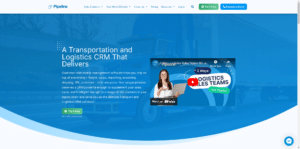What’s the secret to a winning construction sales pitch?
The competition for new customers in the construction business is aggressive and cutthroat. Customers today are educated, demanding, and price-conscious. If you want to nail your construction sales pitch and win new customers, it starts with construction lead management.
What makes construction lead management so important? How does this improve your sales pitch? This blog will answer these questions and give tips on leveraging CRM data to improve your construction sales performance.
How Construction Leads Quality Impacts Sales Pitches
Let’s take a look at the data. According to Startup Bonsai:
- 53% of marketers spend at least half of their budget on lead generation
- Nurtured leads produce 20% more sales opportunities
- Nurtured leads generate 50% more sales at 33% lower costs
This is all great news. How is any of this a problem?
In the ‘How to create sales workflows that close deals 3x faster’ blog, I shared research breaking down your lead flow. Here are some key numbers:
- Only 3% of your prospects are ready to buy at any given moment
- Another 37% need to be nurtured
- A whopping 60% are unqualified leads; they’re not willing to buy
If you’re like most construction companies, you’re spending a significant amount of money on your leads and sales processes. However, only 3% of those leads are active buyers.
To overcome these challenges and improve your construction sales process, you’ll need to apply the following:
- disqualify prospects quickly
- identify prospects who need to be nurtured
- identify the prospects who will be the most profitable for your business
How are you supposed to find this out? The easiest and most accurate way is to use a CRM for construction. But, before we go there, let’s learn how to create a solid construction sales pitch.
Construction Sales Process: The Anatomy of a (Successful) Sales Pitch
The Structure of a Construction Sales Pitch
What does a successful construction sales pitch look like? Well, for starters, it’s targeted and relevant.
Building a successful sales pitch depends on a few important assumptions. They form the building blocks you’ll need to craft a compelling sales pitch that resonates with your construction prospects. Let’s take a look at these assumptions.
- You know what your prospects want
- You’ve qualified your prospects
- You’ve avoided predatory prospects
- You know which prospects need to be closed or nurtured
- Your construction sales pipeline has the precise workflows you need to win more deals
We can create a successful sales pitch formula if we agree on these assumptions. This sales pitch will have the following elements.
- The prospect’s problem or dilemma (e.g., if we don’t fix this now, the cost will triple later)
- Specific and relevant examples of prospects with the worst-case scenario
- Your solution to your prospect’s problem
- Case studies showing how you solved a prospect’s problem
- About your company
This is independent of your quote or proposal. If you’d like to add a quote or proposal to this framework, add it where it makes the most sense.
Examples of a Construction Sales Pitch
Here’s what a construction sales pitch looks like:
Hi Prospect,
When we spoke on [date], you mentioned that you were dealing with the following issues:
- Project delays: You need this project completed within 13 months, no ifs, ands, or buts. If we don’t meet this deadline, we can’t afford to finish the project. However, if we don’t commit to this project, the cost will triple later.
- Cost overruns: The last time you repaired your roof, the cost was 75% cheaper. Thanks to supply chain issues, all of the other contractors are telling you the cost has increased dramatically by another 33%.
- Meeting expectations: Construction site compliance is an important must-have for our project. Our previous contractor used subcontractors who refused to follow the rules, creating a disaster and unnecessary OSHA violations.
Follow-up Actions for a Construction Sales Pitch
If things go well, you’ll just acquire a new client for your construction business. But what if things don’t go as planned? What happens if these issues aren’t resolved? Send a follow-up email.
Below, you can find two email options. You can either send one of them, or send both. Don’t forget to send the email telling a bit about your construction company, what you can do for them, and what you’ve accomplished so far.
Email Option 1
Story of ABC Corp.
One of our suppliers shared this story about your competitor, ABC Corp. They’re facing the same challenges outlined here.
Just one difference.
They didn’t resolve the problem. They procrastinated, and all of the issues you mentioned you’re worried about, your worst fears, came true for them. Their project was delayed by an additional 24 months, leading to a 317% cost overrun. Their project failed to meet expectations, and many of the employees responsible for managing the project lost their jobs. It was a complete and total disaster.
Based on these, here’s what I propose.
First, we have to meet your 13-month deadline. If we don’t, very bad things will happen. We’re going to restructure your project, focusing exclusively on necessities. Extras or nice-to-haves in your project will be treated as secondary.
Next, we need to prevent cost overruns. This means maintaining strict financial controls over your project. Aggressively pushing for refunds and credits, using financing, and substituting materials and supplies are all important.
Finally, we’ll prioritize realistic expectations ahead of time. If we’re going to meet your deadline, this means we’ll need to avoid fuzzy, implicit, or unrealistic expectations. We need to focus on slashing and burning expenses across the board to meet XYZ’s 13-month deadline.
[…]
Email Option 2
Case Study: XYZ Inc. comes in $253K under budget
The Overview
XYZ Inc. needed to finish its roofing project in 13 months. As a property developer, they had several projects on the horizon that they needed to complete. They needed to close the book on this development project so they could begin four new development projects in the pipeline.
The Problem
A looming recession meant XYZ needed to get its risky development projects out the door. If this project continued past the established deadline, they could lose as much as $334K monthly. Cost overruns with their previous developers meant they were behind schedule and over budget.
The Solution
When we were hired, our project deadline was six months away. We needed to work within the budget and time constraints XYZ established. A cost overrun would jeopardize XYZ’s four subsequent projects and create a devastating and ongoing financial loss. We instituted strict financial controls to keep costs low. We found creative ways to finish the project in the required timeframe. We prevented a cost overrun by aggressively pushing for refunds on excesses, pushing for credits, using financing where available, and substituting materials and supplies.
The Results
We finished XYZ’s project with one and a half months left. We narrowly avoided a cost overrun after taking the project over from a previous developer. Using the insights we learned from this tough project, we found an additional cost savings of $2.3 million for their four upcoming development/roofing projects. Here’s what Alton James, Project Manager at XYZ Inc., had to say about our work on their project.
“We came to you guys out of desperation. Our previous contracting team pulled out mid-project. Cost overruns became a very real concern. We weren’t going to be able to finish our project within the 13-month timeline. The financial loss and the employee turnover would have been devastating. When Stacy, your PM, told me you could dig us out of the hole, I laughed.
Four months later, here we are. Our project is actually profitable. That’s just wild.”
[…]
Email Ending
About Your Company
We have a guarantee.
Let us manage your project from A to Z; we’ll come in on time and under budget. Guaranteed, or we’ll pay you 25% of your project price. Our team is among the top 4% of all contractors in North America. Our workers are consistent, highly trained, and certified. Our roofing products come with:
- A 50-year product warranty
- A 10-year workmanship warranty
- Limited Lifetime warranty on siding
Here’s the team that will manage your project.
[…]
Now you know how to find and nurture promising leads. The next step is creating a successful construction sales pitch.
How Pipeline CRM Transforms Your Construction Sales Game
Pipeline CRM helps companies like yours decrease time-to-close, increase productivity by 50% or more, and boost sales by as much as 10x. Don’t take our word for it; let us show you how Pipeline CRM can help you attract, win, and retain customers.
Effortlessly Find Promising, High-Quality Prospects
Which prospects get your attention?
This is an important question. If you spend your time with 60% of prospects unwilling or unable to buy, any construction sales pitch you present will fail. On the other hand, if you spend time with the 37% of prospects who have a need but aren’t yet ready to buy, your construction sales pitch will also fail.
What does this mean then?
Your salespeople need to spend the majority of their time closing deals. They need to spend their time with the 3% of prospects who are willing and able to buy. That’s great, but who are these people, and how do you find them? Your will CRM tell you.
If you’re in construction sales, you know customers want a few things:
- The best contractor their money can buy
- The best service for their money
- The lowest price for their project
- The fastest turnaround/least disruptions for their project
This is helpful information; if you add these details to Pipeline CRM, you can use these data to segment and disqualify your prospects. This is how you optimize your construction sales pipeline and close more sales.
Pro tip: This guide explains how to measure lead quality, allowing you to focus more on promising prospects.
Foster Effective Lead Nurturing
What about lead nurturing? The same thing applies here.
If your prospects respond to content that outlines why your company is the best, you can tailor your offers around that. If they’re looking for the lowest-price contractor (and you want to cater to that), you can segment your prospects that way. Allow your prospects to self-identify.
This is why good documentation – using your CRM – is important. As prospects make their way through your construction sales pipeline, you’ll find you’re able to determine several things:
- Whether you need to close or nurture your prospects
- The anatomy of a sales pitch and closing your prospects
- How to nurture your sales prospects
Now you know how to find and nurture promising leads. The next step is creating a successful construction sales pitch.
CRM Software Feeds a Winning Construction Sales Pitch
General contractors face an uphill battle filled with heavy competition, low margins, and skyrocketing supply costs. Customers today are educated, demanding, and price-conscious. If you want to nail your sales pitch and win new customers, it starts with construction lead management.
As prospects make their way through your construction sales pipeline, you’ll find you’re able to determine several things:
- Whether you need to close or nurture your prospects
- The anatomy of a sales pitch and closing your prospects
- How to nurture your sales prospects
This is how you create a compelling construction sales pitch, nail it, and close more sales.
Use the data from your construction CRM to segment and disqualify your prospects.
Pipeline CRM helps construction companies like yours decrease time-to-close and boost productivity. Learn how Rainier Custom Homes reduces the sales cycle by 53%, cutting it from 130 to 62 days with Pipeline CRM.
Sign up for a 14-day free trial, and see how we can help you attract, win, and retain customers.





